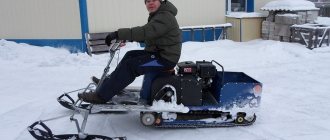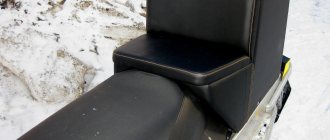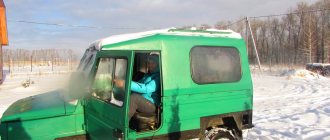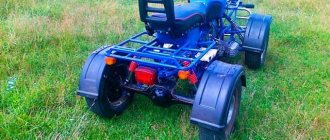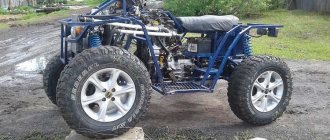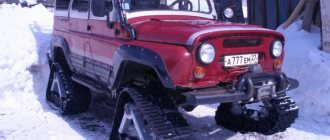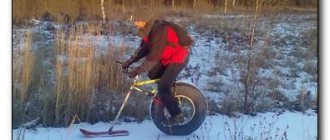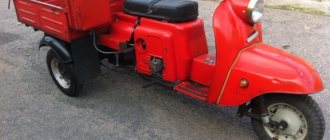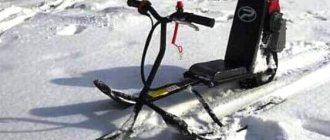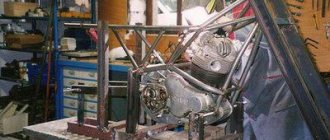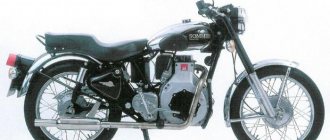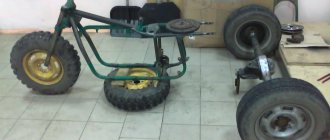Fishermen, hunters and winter sports enthusiasts use snowmobiles to travel to the best vacation spots. Even inexpensive models of such equipment cost about a hundred thousand rubles, often more. Those who want to save money can assemble a homemade snowmobile on tracks in a regular garage workshop. The cost of parts for construction does not exceed 40 thousand rubles.
Snowmobile device
Homemade snowmobiles are built on caterpillar tracks. The tracks are driven by an internal combustion engine mounted on a rigid metal frame. They are supported in working position by wheels and special rollers. Main options:
- With a solid or fracture frame.
- With rigid or shock-absorbed suspension.
- With an engine from a walk-behind tractor or from a stroller.
Short skis are used for steering. Light snowmobiles (weighing up to 100 kg), designed to travel at a maximum speed of up to 15 km/h, do not necessarily require a braking system. They stop easily when engine speed drops. make a homemade snowmobile on tracks using the following algorithm:
- Selection of engine, calculation of frame and chassis.
- Frame assembly by spot welding.
- Steering device.
- Installing the engine in the design position on a temporary mount.
- Checking the structure for resistance to capsizing.
- If the test is successful, the frame is completely welded and the engine is installed.
- Installation of drive system, axles.
- Assembly and installation of tracks.
- Installation of body parts.
After this, final tests are carried out. If the snowmobile drives normally and does not tip over, then it is driven into the garage and disassembled. The frame is cleaned of rust, painted in 2 layers, the remaining elements are finished, and then a homemade snowmobile on tracks is assembled with your own hands.
Wood frame
The basis of a snowmobile made from a walk-behind tractor will be its frame, which can be made of different materials. One of the most popular options for creating a frame is wood.
Wooden blocks are perfect for the structure, as they are light and at the same time very durable. In addition, you can find the right amount of timber in the yard. Essentially making a frame means assembling a sled for a snowmobile.
If there is no or not enough wood on the site, its cost is not very high. In order to make a frame from wood, in addition to timber, you will need the following: iron in sheets, a metal cutter, a drill, drills, bolts, nuts, a saw.
In order to rid the frame of burrs and make it as smooth as possible, you will need sandpaper or a sanding attachment on a drill.
A homemade snowmobile made of wood has many advantages over other models except lightness. It is very easy to repair such a frame not only at home, but also on the road, because the material can be found in any forest belt.
This option is unlikely to fall through the ice, and if this happens, it will stay afloat.
Engine selection
Gasoline engines are used for walk-behind tractors or strollers. Engine speed is controlled by a throttle handle located on the steering wheel. To make a homemade tracked snowmobile with your own hands, the easiest way is to use ready-made small-volume engines for walk-behind tractors with pre-installed:
- Fuel tank.
- Ignition system.
- Reduction gearbox with a ratio of 1:2.
- Centrifugal clutch, automatically activated when the speed increases.
The power of these engines does not exceed 10 horsepower, but they are easy to install: the technician does not need to separately assemble the ignition system, connect fuel pipes, adjust the clutch, etc. There are different options on the market:
| Brand | Model | Power, l. With. | Volume, cm3 | Weight, kg | Approximate price, thousand rubles. |
| Kipor | KG160S | 4,1 | 163 | 15,5 | 20−25 |
| Sadko | GE-200R | 6,5 | 196 | 15,7 | 15−20 |
| Lifan | 168 FD-R | 5,5 | 196 | 18,0 | 15−20 |
| Zongshen | ZS168FB4 | 6,5 | 196 | 16,0 | 10−15 |
| Nomad | NT200R | 6,5 | 196 | 20,1 | 10−15 |
| Brait | BR-177F-2R | 9,0 | 270 | 30,0 | 10−15 |
| Honda | GX - 270 | 9,0 | 270 | 25,0 | 45−50 |
If it is not possible to purchase a ready-made engine from a walk-behind tractor, then you can use an engine from a stroller. Such engines are 10-15 horsepower more powerful, but require self-assembly. The system includes:
- Engine.
- Clutch.
- Gearbox.
- Gas tank (volume 5-10 liters).
- Muffler.
- Generator.
- Electronic ignition switch and coil.
Some of the elements will come from old motorcycles (“Minsk”, “Vostok”, “Java”, “Ural”). The gas tank is located as close as possible to the carburetor to reduce the length of the pipes.
Optional equipment
Once you have decided on the purpose of buying a snowmobile and its type, you should think about tuning for your new “favorite”. It would be a mistake to think that additional equipment is needed only for beauty or to improve the sporting qualities of a snowmobile. In some cases, it may simply be necessary to supplement the model with one or another part in order to improve ride quality or protect the structure: grille filters, mud flaps, bumpers, frame reinforcements, mirrors. To increase luggage capacity, you can order a set of side cases. For driving comfort - heated driver and passenger visors, GPS navigator. In short, the choice of tuning parts for snowmobiles is huge, and the use of each of them can be useful.
Frame and body
Before work, it is recommended to draw up a drawing of the frame. The structure is welded from a square pipe 25 x 25 mm with a wall thickness of 2 mm. For a payload of over 150 kg, the section size is increased to 30 x 25 mm. The loading area and body elements are covered with plywood. The seats are selected with a hydrophobic coating.
In the center of the fracture frame there is a hinge that allows rotation around a vertical axis. The maximum rotation angle is limited by welding metal plates. The front half is used for steering, and the engine is placed on the rear half frame.
The solid frame is welded in the form of a rectangle, inside of which axles and tracks are located. The engine is placed in front on a special platform, rigidly welded to the rest of the frame. In both cases, the motor is installed in the transverse direction (the shaft faces the end).
Types of drives and their design
Are there two drivetrains for snowmobiles? drive on pneumatic wheels and drive on tracks, we will talk about them below in detail.
In the case of wheel drive? Such a snowmobile can conditionally be called all-wheel drive, since both the ski and the pneumatics are support-control and driving. Its rear axle is designed extremely simply: a welded and solid drive shaft instead of the usual axle shafts, two wheels without a differential. This helps to maintain excellent control of the unit on excessively snowy and slippery roads. And to make turns perfect, the ski has two undercuts on the side, made of duralumin, 35 by 35 mm.
The large driven sprocket is welded to the hub, which in turn is mounted on the shaft. A pin-bolt helps her not fly off it. The most important thing: the plane of rotation of the sprocket on the output shaft and the position of this sprocket must coincide perfectly. The brake drum is also mounted there.
To tension the chain, the shaft must move and the housing must be secured to the corner extensions.
Pneumatics? These are cameras taken from the wheels of a tractor trolley, which are put on frame disks and placed in the bandages of conveyor belts. The longitudinal and transverse tires are fastened with bolts, which in parallel serve as lugs thanks to the high protruding rods.
The torque to the engine from the power unit is transmitted via a chain drive with a gear ratio of 3.5, where the sprocket, which is mounted on the rear shaft, has 28 teeth, on the front? 8 teeth. For this type of drive to work ideally, the engine must have a forced cooling system.
To make pneumatic wheels yourself, you need to complete four steps:
- two disks made of metal sheets must bridge each other. Afterwards they are attached to the sleeve, and then the camera is put on them. The latter can be fixed either with pieces of conveyor belt, or with protectors of another chamber;
- jumpers also need to be attached to the disks, onto which the side rings must then be welded;
- when installing the central disks, you will need a spoke made of a metal sheet or pipe;
- the two discs that are mounted on the hub should be similar to the discs of a scooter wheel.
The all-wheel drive track consists of a belt that transmits forces to the driven one from the drive pulley. The body consists of spiral elements that increase its strength and add flexibility when moving. The side faces have a slope that corresponds to the edges of the pulleys, and the width of the top face is ? the width of the stream at the pulley. The axis of the driven shaft is parallel to the engine camshaft, and the driven pulley sits on it.
Belt drive? the most wearable, and the requirements for it should be the following:
- rigidity, otherwise it will simply burst during peak load;
- thickness, which is regulated. Otherwise, it must be replaced;
- The disk that drives the drive will also need to be replaced if signs of excessive wear are noticeable.
You need to choose a belt correctly and responsibly: if it is too short, the load on the drive will be extremely large, and if it is too long? will hang out. In addition, today there is a variable-speed belt, which has its own advantages:
- the belt does not stretch due to rotation of the pulleys;
- the cross section is an indicator of particular rigidity;
- temperature conditions that can be easily maintained by the belt? from -300 to +800 degrees Celsius;
- abrasion resistant;
- He is not afraid of heat or chemicals;
- high gear ratio and throughput;
- uniform load distribution due to resistance to distortions and displacements on the pulleys;
- high-speed transmission is carried out extremely accurately;
- works silently and for a long time.
There are several main rules for operating a belt drive:
- for approximately the first 50 km it is necessary to give half speed;
- the service life of the belt is extremely significantly reduced by the discrepancy between the rotation axes of the driven and driving pulleys or the shaft;
- wears out the gear shift belt at high speeds, that is, the required value? 3500?5000 rpm;
- If the belt is worn out, it means it is slipping somewhere. To correct the situation, you should check the tension of the pulley and either clean it, replace its worn springs, or check the seal of the bearing.
If we talk about drives in the language of motorists, then there is the so-called rear-wheel drive, the technology of which is still new on the snowmobile market, although it has already gained its admirers, because:
- fuel consumption is reduced by 72%;
- traction power increases by 71%;
- The speed of the unit increases by 10%.
Does it have three points of contact? This is the drive axle at the rear, part of the track at the front, and the runners. When distributing weight on any of the axles, it gives its advantages and disadvantages in operation.
On a front wheel drive snowmobile, the top portion of the track is tensioned while the rising portion remains relaxed. However, mention of drives is extremely rare in the description of snowmobiles, and their division into tracked and wheeled? comfortable and familiar.
Drive system
A small diameter drive sprocket is installed on the engine output shaft. From it, torque is transmitted through a chain to the driven shaft, located under the engine seat. On the driven shaft there are:
- Large diameter driven sprocket.
- Gear wheels that drive the tracks.
- Guides for tracks.
The driven shaft is mounted on the frame using bearings. Gear wheels push the tracks, causing the tracks to move. The chain and sprockets are removed from one device. Old motorcycles and snowmobiles (Buran) are suitable donors. Gear wheels for tracks can only be removed from other tracked vehicles.
The guide rollers rotate with the shaft, are attached next to the gears and serve to tension the belt. They are made of wood or plastic and have a layer of soft rubber at the ends. Rubber prevents damage to the track. It is easy to make such rollers yourself by securing the edging with a furniture stapler.
Making a snowmobile using a chainsaw
A chainsaw is a universal tool for working with large wooden beams that are difficult to deform.
With this tool you can make a real snowmobile.
Let's figure out how to make a snowmobile with your own hands from a chainsaw. First of all, pay attention to the 2nd subtitle of the article, which indicates all the necessary materials for construction. So let's get started:
- Based on the dimensions of the future snowmobile, start adjusting the dimensions of the bars with a chainsaw.
- Next, using a chainsaw, we begin to cut out small parts that will be needed to securely fix the lower support.
- Next comes the same sequence of actions as already written earlier.
Calculation and assembly of caterpillars
The caterpillar is a tape, on the outer surface of which tracks are attached. Tracks are rigid lugs installed along the entire length of the tracks. Track options:
- Made from 3mm thick transport tape.
- From a car tire.
- From V-belts.
- Ready-made factory-made tracks.
The conveyor belt must be looped. Its strength is only sufficient for light snowmobiles with engines no more powerful than 10 liters. With. Car tires are stronger than tape and are suitable for powerful engines. Solid tires do not need to be looped, so the likelihood of a rupture is minimal. It is more difficult to choose a tire of the required length than a tape.
Finished tracks are removed from other similar equipment (snowmobiles “Buran”, “Sherkhan”). They are equipped with lugs from the factory. The products are not suitable for use with low-power motors from walk-behind tractors. Homemade snowmobiles made from Buranovsky tracks must have gears from the same “donor”.
The size of the caterpillar is selected according to the required driving characteristics: the larger the width, the lower the handling, but the higher the maneuverability. The minimum area of the contact patch from the snowmobile (skis and tracks) must be such that the pressure from the equipped vehicle does not exceed 0.4 kg/cm2 of surface. Light snowmobiles use a 300 mm wide conveyor belt, cut lengthwise into 2 strips of 150 mm each.
Preparing the Tape
The tracks are attached to homemade tracks with M6 bolts with a wide head. The bolts are fixed with a nut, a washer and a groover are used. Before fastening, leading holes with a diameter of 6 mm are drilled in the tape and tracks. When drilling, use a jig and wood drills with special sharpening.
The conveyor belt is also looped with M6 bolts. To do this, the edges of the tapes are overlapped with an overlap of 3-5 cm, the connection contains 1-2 rows of bolts. For a 150 mm wide track, the following distances are maintained:
- From the edge of the tape 15-20 mm.
- Between bolts on tracks 100-120 mm.
- Between the bolts when banding 25-30 mm.
In total, one track requires 2 bolts, and one belt connection requires 5-10 bolts, depending on the number of rows. When using car tires, only the tread is left, and the sidewalls are removed with a shoe knife.
Homemade lugs
The tracks are made of polyethylene pipe with a diameter of 40 mm with a wall thickness of 5 mm, sawn in half in the longitudinal direction. The entire section of the lug is adjacent to the tape. In light snowmobiles, one track connects the tracked pair. With a track width of 150 mm, the track length is 450-500 mm.
The lugs are cut using a wood circular saw. They use a special machine with two guides (metal and wood), rigidly fixed on a fixed tabletop. The walls of the pipes are sawed one by one.
The distance between the tracks depends on the parameters of the gears on the drive shaft. Typically 5−7 cm. The specified distance is maintained with an error of no more than 3 mm. Otherwise, the operation of the drive is disrupted: the lugs “run” onto the teeth of the drive wheels, the caterpillar begins to slip and fly off the rollers.
Scope of application of covered machines
Are snowmobiles with a covered cabin aimed at servicing linear objects? pipelines and communication and power lines. They can also be used in the protection of objects for various purposes. And of course, it is indispensable for lovers of hunting and fishing.
The Russian defense industry intends to use such a snowmobile for Arctic units. This solution will make it possible for domestic manufacturers to make an all-terrain army vehicle, equipped not only with communications equipment, but also with fire weapons to destroy the enemy, even more interesting.
